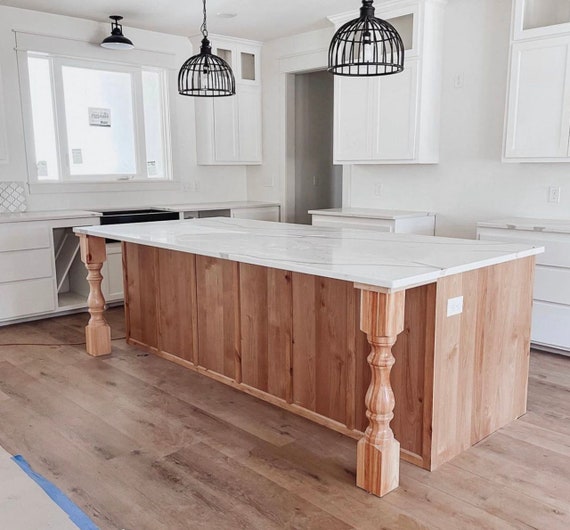A Comprehensive Overview to Choosing the Right Kitchen Island Leg
A Comprehensive Overview to Choosing the Right Kitchen Island Leg
Blog Article
The Significance of a Sturdy Cooking Area Island Leg in Creating a Practical Food Preparation Area
A strong kitchen area island leg serves as an essential element in establishing a functional food preparation atmosphere, offering required support for both the kitchen counter and numerous cooking area tasks. As kitchen areas develop into multifunctional locations for food preparation, eating, and interacting socially, the choice of materials and style factors to consider for island legs ends up being progressively crucial.
Advantages of Sturdy Island Legs
Offering crucial support, sturdy cooking area island legs play an essential role in boosting the performance and toughness of kitchen area islands - kitchen island leg. These legs not only birth the weight of the countertop and any kind of extra items positioned on the island, yet likewise add to the general stability of the structure. A well-supported cooking area island makes certain that it continues to be practical and upright, even under heavy use, which is particularly vital in busy kitchen environments
In addition, sturdy island legs can enhance the visual allure of the kitchen area. They supply a strong framework that can enhance various style styles, from modern-day to conventional. This versatility enables homeowners to personalize their cooking area islands according to personal taste while making certain that the structural stability continues to be uncompromised.
In enhancement to their helpful function, robust kitchen island legs can also improve safety. Eventually, spending in tough cooking area island legs is important for a functional and visually pleasing cooking area.
Products for Kitchen Island Legs
When choosing materials for kitchen island legs, resilience and visual appeal are critical factors to take into consideration. One of the most typical materials consist of wood, metal, and engineered timber, each offering distinct benefits.
Wood, such as oak, maple, or cherry, is a classic selection because of its stamina and ageless charm (kitchen island leg). It can stand up to considerable weight and is resistant to use, making it perfect for high-use kitchen area atmospheres. Furthermore, wood can be stained or repainted to match various kitchen area designs
Steel legs, frequently crafted from stainless-steel or functioned iron, give a modern and industrial look. They are incredibly solid and can sustain considerable loads while being immune to moisture and warmth, which is useful in a cooking area. Metal legs can likewise be quickly cleansed, boosting their usefulness.

Layout Considerations for Security
The choice of materials for cooking area island legs directly affects the style considerations for security. When creating a kitchen area island, it is critical to review the weight-bearing ability of the chosen products. Larger materials, such as strong timber or metal, typically offer greater stability, particularly under the tension of day-to-day use.
In addition, the leg design need to incorporate appropriate geometry to boost stability. A bigger base increases the assistance location, reducing the threat of tottering or tipping. Factor to consider ought to additionally be offered to the height of the legs; out of proportion leg lengths can cause inequality, jeopardizing the total stability of the island.
Additionally, the distribution of weight throughout the island is vital. Guaranteeing that the leg positioning aligns with the heaviest parts, such as counter tops and devices, will certainly further improve stability.
Upkeep Tips for Durability

Depending on the material of the legs-- whether wood, metal, or composite-- appropriate cleaning approaches ought to be my company used. Steel legs might require a light polish to prevent rust and maintain their radiance.
Furthermore, tightening screws and bolts routinely can guarantee stability and avoid tottering. If the cooking area island experiences hefty usage, consider reinforcing the legs with additional brackets or supports to enhance resilience. Last but not least, using a protective surface or sealer can safeguard against wetness and discolorations, lengthening the life-span of the legs. By following these maintenance pointers, homeowners can guarantee their cooking area island legs continue to be useful and durable for many years to find.
Choosing the Right Leg Style
Routine upkeep makes certain that kitchen island legs remain tough and useful, but selecting the right leg design is just as important for both looks and assistance. The option of leg style can substantially influence the general design and harmony of your kitchen.

Performance is another critical aspect. For instance, thicker legs or those with a durable base can sustain much heavier kitchen counters and tools, enhancing the island's utility. Conversely, slender legs may create a ventilated look, suitable for lighter designs but potentially much less supportive.
Conclusion
In summary, the value of tough kitchen area island legs can not be overstated in the production of a useful cooking location. These legs give necessary support, enhance security, and contribute to the overall visual of the kitchen.
A sturdy cooking area island leg serves as an essential component in establishing a functional food preparation environment, supplying necessary assistance for both the countertop and different kitchen tasks.Providing necessary support, strong kitchen island legs play an essential role in improving the capability and toughness of kitchen islands. Eventually, spending in durable cooking area island legs is essential for a useful and aesthetically pleasing cooking location.
Consideration should additionally be offered to the height of the legs; out of proportion leg lengths can lead to discrepancy, jeopardizing the total stability of the island.
Wooden legs give heat and a classic look, while steel legs offer a contemporary and commercial feel.
Report this page